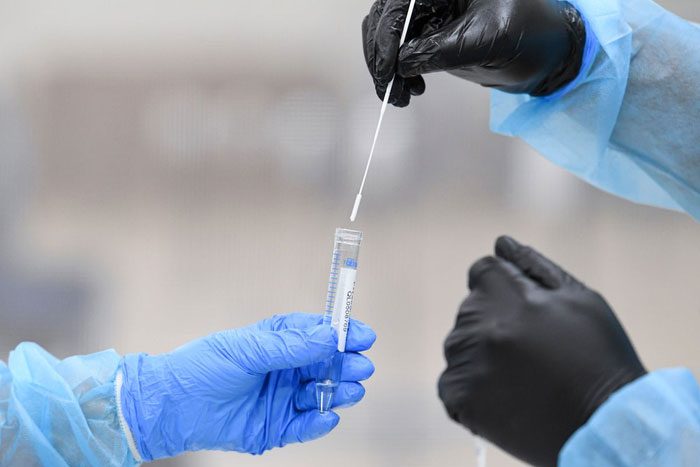West Virginia University scientists are applying machine learning and geographic data to understand where places with low vaccination rates need boosted outreach for community testing.
West Virginia University researchers Brian Hendricks and Brad Price are using machine learning and geographic information systems to identify communities in West Virginia where COVID-19 vaccine uptake is especially low. What the technology reveals can help get testing resources to the people who need them the most: those who live where low vaccination rates make persistent, localized outbreaks likely.
“In late 2020 and early 2021, when the vaccine came out, there was a one-third drop in testing,” said Hendricks, an assistant professor of epidemiology and biostatistics in the School of Public Health. “That’s a huge issue because a drop in testing hurts your epidemic modeling, your calculation of the basic reproductive number, your ability to plan for research allocation—all of that. So, as the pandemic evolves, we have to keep testing to monitor localized outbreaks and understand when a new variant is introduced.
The National Institute on Minority Health and Health Disparities—a division of the National Institutes of Health—has awarded WVU $2.15 million for the project.
Hendricks, Price and their colleagues will create and validate new machine-learning tools and GIS analyses to maximize the use of localized information on case counts, testing trends, emerging variants and vaccinations. In doing so, they’ll pinpoint counties that face an increased risk of potential outbreaks, and they’ll predict where testing will be most crucial.
Machine learning is a form of artificial intelligence that uses huge amounts of frequently updated data to draw conclusions that grow more and more accurate. Because it’s dynamic—rather than static—it’s a boon for COVID researchers.
“We want to take into account the changes that can occur over time,” said Price, an assistant professor or the John Chambers College of Business and Economics who focuses on machine learning. “Because we know the pandemic changes with time, right? We’ve seen variants pop up. We’ve seen surges in cases. We’ve seen cases fall off. We’ve seen masks go on and come off. And now we’re talking about booster shots. So, there’s a lot of things we have to take into account. If we’re just saying, ‘This is the data. Analyze it,’ without considering how it’s moved over time and how it will continue to move over time, we’re missing a big piece of the puzzle.”
Once the researchers know where the COVID hotspots are, they can work with community members in those locations to determine the best ways to get more people tested
“We’re conducting interviews to understand—from their perspective—what are the barriers to COVID testing?” Hendricks said. “How does the community feel about COVID testing? What are some things we could do to motivate communities to participate in continued testing? And why is this important?”
By avoiding a one-size-fits-all approach and acknowledging that communities are unique, the researchers hope that efforts to increase testing rates will bear measurable successes.
What might such efforts look like? Local first responders, for instance, might attend a big cookout that’s free, open to the public and advertised on social media. Staff from QLabs—a research partner of Hendricks and Price—could be available at the cookout to conduct COVID testing. The first responders might circulate among the community members and encourage them to be tested.
“I want them to do what they do every day, which is go up to the people who are eating the food at these events and say, ‘Hey, I care about you. How’s your family doing? How’s your mom doing? Have you gotten tested lately? You haven’t? Well, I care about you. Let me walk you up to the table where you can get tested,’” Hendricks said.
The awarded grant marks the second phase of NIH’s Rapid Acceleration of Diagnostics for Underserved Populations initiative. RADx-UP aims to reduce disparities in underserved populations, whom COVID-19 affects disproportionately. The overarching goal of the initiative is to understand and ameliorate factors that place a disproportionate burden of the pandemic on vulnerable populations.
The prior phase of the program—led by Sally Hodder, the associate vice president for clinical and translational science and the director of the West Virginia Clinical and Translational Science Institute—focused on expanding the scope and reach of COVID testing interventions to reduce these disparities.
“The next RADx phase will be critically important as we address future COVID activity,” Hodder said. “Drs. Price and Hendricks will focus on those areas of West Virginia with low vaccine uptake. We know that individuals who have not received COVID vaccines are at increased risk for severe COVID disease and even death. However, new oral drugs are now available that greatly decrease that risk. Therefore, testing is extremely important as folks testing positive for COVID will be able to receive pills that decrease their chances of hospitalization.”
How Hendricks and Price collect and analyze the data could, in itself, prove useful in the future. After all, this wasn’t the first pandemic the world has experienced, and it won’t be the last. According to WHO, the United Nations, the World Economic Forum and others, climate change is apt to increase the spread of infectious diseases in the years to come.
“At the beginning of the pandemic, we couldn’t do anything because we didn’t have data,” Price said. “In the middle of the pandemic, we couldn’t do anything because we didn’t have an infrastructure for that data. Now we’re starting to piece it together. And I think one of the things I’m going to be focusing on is making sure we have that infrastructure so that the next time this happens, we have our policies, protocols and systems built, and the second we have data available, we can hit the ground running.”
This project is supported by the National Institute on Minority Health and Health Disparities of the National Institutes of Health under Award Number 1U01MD017419-01.



